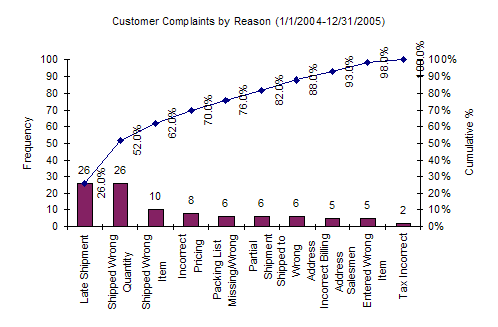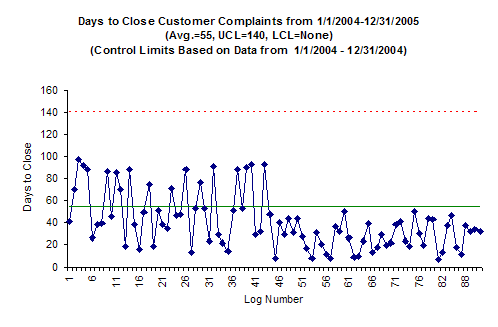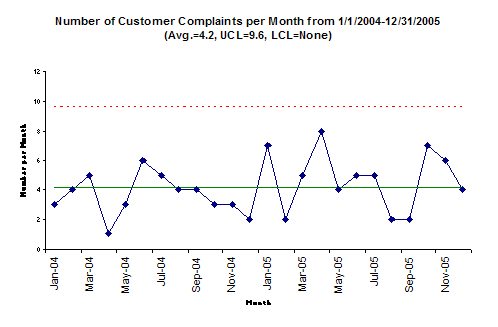June 2006
In this issue:
Now matter how great your organization is, sometime it will happen. A customer will complain about something. After all, haven’t you complained about something when you have been the customer? All companies should have a customer complaint process in place. This process should cover how you respond to and handle customer complaints. And you need to track your customer complaints using statistical process control (SPC). SPC helps answer these questions about customer complaints:
- Which customers complain the most?
- What causes customer complaints?
- How often do we get customer complaints?
- How quickly do we close customer complaints?
- Are complaints increasing or decreasing?
- What complaints are open?
- How long have they been open?
Unfortunately, many customer complaint programs don’t provide this information in the format of SPC. This month’s e-zine shows how you can collect and analyze data on customer complaints using SPC.
What is a Customer Complaint?

For example, one definition of a customer complaint might be:
A customer complaint is defined as any contact made by a customer with the purpose of expressing dissatisfaction, whether justified or not.
Now that you have defined what a customer complaint is, you need a process for handling that complaint.
Developing the Customer Complaint Process
If you do not have a formalized customer complaint process, you should develop one. This includes developing a format for collecting the data. An overview of one possible customer complaint process is given below. The first part of the process involves finding out what the complaint is and taking immediate action to take care of the customer.
A customer complains via some medium (e.g., phone, e-mail, fax). The employee receiving the complaint records the information as follows:
- Date
- Customer company
- Customer account number
- Person issuing complaint
- Complaint registered (what is the complaint?)
- Customer PO (if available)
- Customer invoice number (if available)
- Employee receiving complaint
The complaint then should be sent to the employee who is responsible for taking care of the problem immediately. This employee records the immediate action that he/she takes, the employee’s name, and the date he/she contacted the customer. This employee also assigns an error code to the complaint. As part of your data collection, you should have codes for what caused the complaint. For example, for a distribution company, you might have codes such as:
- Shipped Wrong Item
- Shipped Wrong Quantity
- Shipped to Wrong Address
- Salesmen Entered Wrong Item
- Packing List Missing/Wrong
- Late Shipment
- Partial Shipment
- Incorrect Billing Address
- Incorrect Pricing
- Tax Incorrect
These codes require a person to select a reason for a customer complaint. You can also have a code like “Other” for items that don’t fit into any of the categories.
The second part of the process involves taking action to find and remove the root cause of the problem. The complaint is sent to the department head responsible for that complaint. The department head records the date the complaint was received. The root cause of the problem is found using a problem-solving methodology (for example, see our May 2004 e-zine). Corrective action to remove the root cause is taken and recorded. A test must be done to ensure that the corrective action works.
The last part of the process involves letting the customer know that the root cause has been removed. This is often done by the Customer Service Manager. The date the customer was contacted is recorded and the complaint is officially closed.
Collecting the Data
Once you define what a customer complaint is, you must define what data need to be collected and how they will be collected. Answer the following question: what information do I want if a customer complains? Some possibilities include:
- Date of Complaint
- Customer name
- Customer location
- Person issuing the complaint
- What the complaint is about (what happened)
- Person receiving the complaint
- Process/department where problem occurred
- Date complaint closed
Examining your customer complaint process (like the one above) will also give you ideas about what information you have. These data can be tracked easily in a Microsoft Excel spreadsheet. Microsoft Access can also be used. In addition, there are numerous customer complaint tracking software programs available. Most do not provide a good method of analyzing the results using SPC, but with most you can export the data to Excel to do the analysis.
Analyzing the Results: Pareto Diagrams
Pareto diagrams provide an easy method of determining what problems occur most frequently. The Pareto diagram is a special type of bar chart used to determine which problem to work on first to improve a process. It is based on what is now called the Pareto principle or the 80/20 rule, i.e., 80% of our problems are probably due to only 20% of the possible causes. The Pareto diagram allows us to separate the “vital few” from the “trivial many.” This permits us to focus our time and resources where they will be most beneficial.
You can do Pareto diagrams on many things related to customer complaints. These include reasons for customer complaints, complaints by customer, complaints by responsible departments, etc. An example of a Pareto diagram by reason for customer complaints is shown above. This Pareto diagram shows that late shipments and shipping the wrong quantity are the major reasons for customer complaints. Problem solving can now occur to reduce the frequency of these two problems.
Analyzing the Results: Days to Close
The time it takes to close a customer complaint should be tracked using a control chart. The objective, of course, is to decrease the time it takes to close a complaint. The date closed should be part of the data collection. Then you can simply determine the number of days from the date the complaint was made to the date it was closed. An individuals control chart can be used to monitor the results. An example of a control chart on days to close customer complaints is shown above. What does this chart tell you about the process of closing customer complaints?
Analyzing the Results: Number of Complaints
Is the number of complaints increasing, decreasing, or staying the same? How do you know? The only way to know for sure is to chart the number of complaints over time using a control chart. An example of a control chart for the number of customer complaints per month is shown above. Again, the individuals control chart is used, but the c control chart could also be used. What does this chart tell you about the number of complaints?
Summary
This month’s publication looked at how you can use Pareto diagrams, histograms and control charts to monitor customer complaints.


